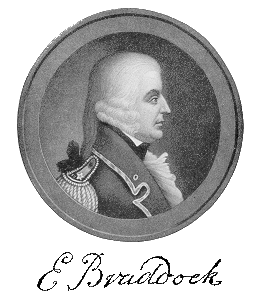General Braddock Defeated
Richard Cavendish describes how Major-General Edward Braddock arrived in Virginia to take command against the French in North America, but was defeated on July 9th, 1755.
 Major-General Edward Braddock arrived in Virginia in February 1755 to take command against the French in North America. His first objective was Fort Duquesne, deep in the wilderness at the Fork of the Ohio River, where the city of Pittsburgh stands today. Braddock was about sixty, a short, stout, bad-tempered martinet with little experience in action and none of the type of fighting that was in store for him. His rudeness and arrogance made a thoroughly bad impression on the colonials and were to contribute to a jaundiced view of the British officer class. On arrival, however, he received a congratulatory letter from a Virginian lieutenant-colonel of twenty-two named George Washington, who was privately thinking of a career in the British regular army. Braddock soon discovered that Washington knew the wilderness country and took him on his staff as an aide. Two regiments of infantry, the 44th and 48th, arrived from England and after some difficult months making preparations and recruiting additional troops locally – with Braddock’s temper almost permanently at boiling point – the army marched for Fort Duquesne.
Major-General Edward Braddock arrived in Virginia in February 1755 to take command against the French in North America. His first objective was Fort Duquesne, deep in the wilderness at the Fork of the Ohio River, where the city of Pittsburgh stands today. Braddock was about sixty, a short, stout, bad-tempered martinet with little experience in action and none of the type of fighting that was in store for him. His rudeness and arrogance made a thoroughly bad impression on the colonials and were to contribute to a jaundiced view of the British officer class. On arrival, however, he received a congratulatory letter from a Virginian lieutenant-colonel of twenty-two named George Washington, who was privately thinking of a career in the British regular army. Braddock soon discovered that Washington knew the wilderness country and took him on his staff as an aide. Two regiments of infantry, the 44th and 48th, arrived from England and after some difficult months making preparations and recruiting additional troops locally – with Braddock’s temper almost permanently at boiling point – the army marched for Fort Duquesne.Progress was slow and Braddock presently left about one-third of his force to bring the supply train on behind under Colonel Dunbar of the 48th, while pressing on through forest country with perhaps 1,500 men. They were greeted by rude messages the French had left scrawled on trees stripped of bark along the way. Soon after midday on July 9th, after fording the Monongahela River ten miles or so from Fort Duquesne, Braddock’s vanguard proceeding through the trees in their red coats were surprised by an enemy force close to 900 strong. Most of them were American Indians, the rest French and Canadians. Fiendish war-whoops sent chills down British spines as the Indians darted down each flank of the British and caught them in a cross-fire, while the French blocked the front. Many British officers were killed or put out of action and the men ran for it, colliding with their comrades moving up in support. Efforts to stop them, Washington wrote, were about as much use as trying to halt a stampede of wild bears. British troops fired on each other in panic while Braddock and the surviving officers tried vainly to rally them. Washington’s hat was taken off his head by a bullet and Braddock was shot in the chest – quite possibly by one of his own side. Washington put Braddock on a cart and led as many of the British as he could get to listen to him back across the Monongahela, while the whooping Indians lingered to scalp the dead and wounded before taking a dozen prisoners to Fort Duquesne where they gleefully burned them alive. Braddock meanwhile had ordered Washington back to find Colonel Dunbar and bring him forward to cover the British retreat, though when Dunbar’s men heard what had happened, quite a few of them moved smartly in the other direction.
Presently Braddock appeared, swaying to and fro on a horse. He had been shifted to a litter, but his men refused to carry him. He died on July 13th at a place called Great Meadows, as the whole army retreated, and was buried there next day. Braddock’s batman, Thomas Bishop, attached himself firmly to Washington and would continue as his valet and personal factotum for more than thirty years.




